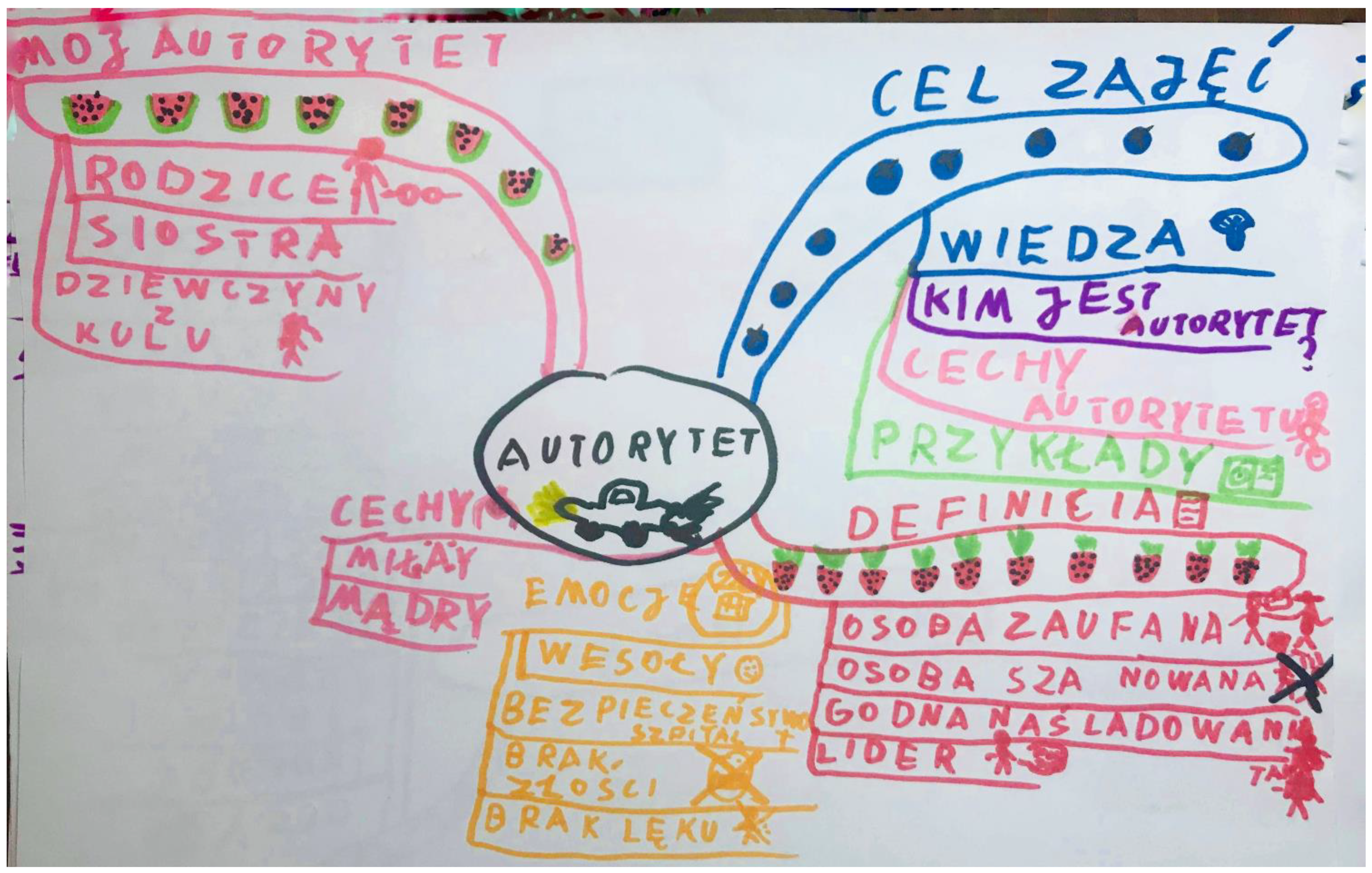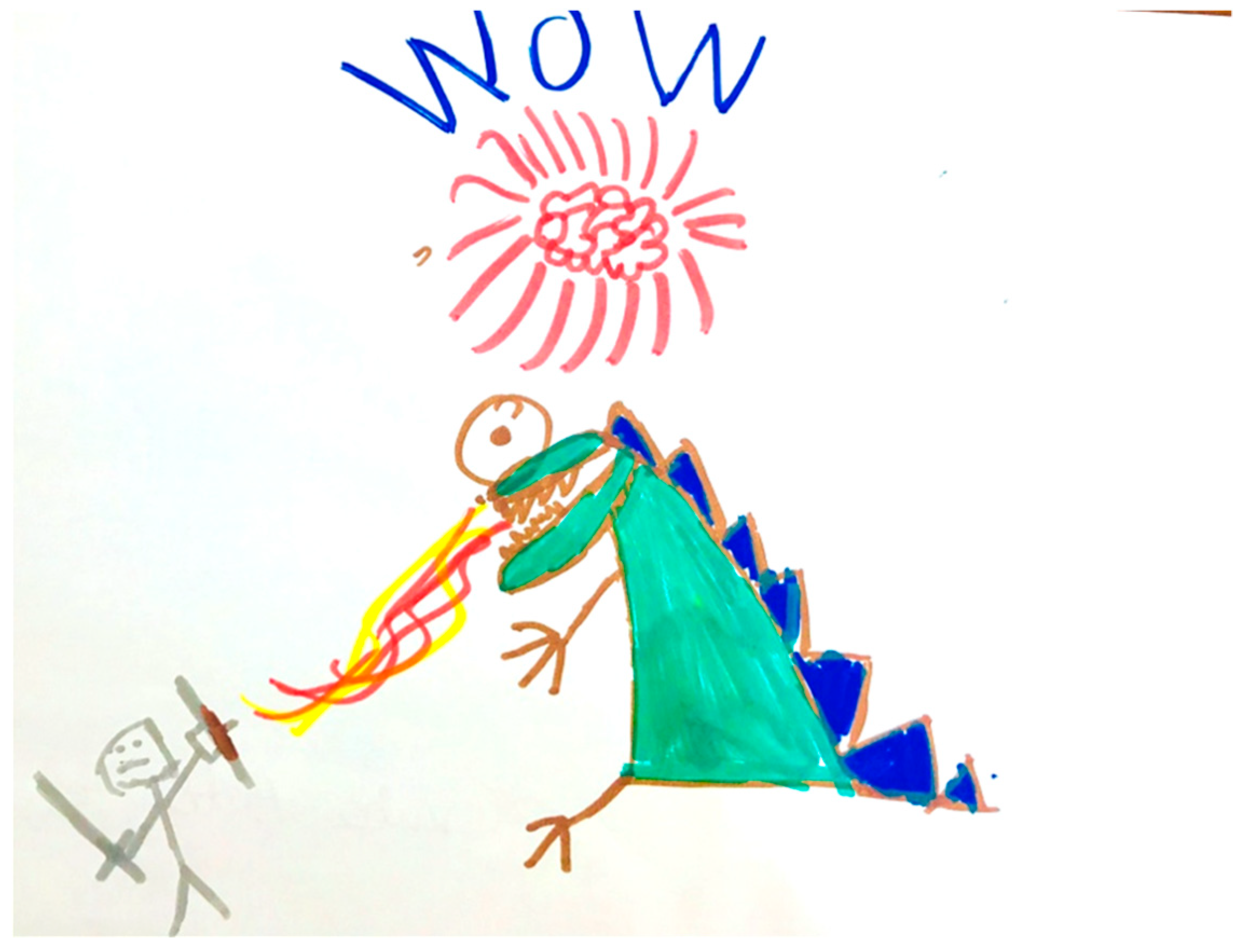The Influence of Metacognitive Strategies on the Improvement of Reaction Inhibition Processes in Children with ADHD
Abstract
1. Introduction
2. Materials and Methods
2.1. Description of the Experimental Procedure
2.2. Description of Research Tools
3. Results
4. Discussion
5. Conclusions
Author Contributions
Funding
Institutional Review Board Statement
Informed Consent Statement
Data Availability Statement
Acknowledgments
Conflicts of Interest
References
- Filippetti, V; López, M. Las Funciones Ejecutivas En La Clínica Neuropsicológica Infantil. [Executive functions in clinical child neuropsychology]. Psicol. Desde El Caribe 2013, 30, 380–415. [CrossRef]
- Nigg, J.T.; Willcutt, E.G.; Doyle, A.E.; Sonuga-Barke, E.J. Caus al heterogeneity in attention- deficit/hyperactivity disorder: Do we need neuropsychologically impaired subtypes? Biol. Psychiatry 2005, 57, 1224–1230. [Google Scholar] [CrossRef] [PubMed]
- Barkley, R.A. Behavoral inhibition, sustained attention, and executive functions: Constructing a unifying theory of ADHD. Psychol. Bull. 1997, 121, 65–94. [Google Scholar] [CrossRef] [PubMed]
- Ramos–Galarza, C.; Perez–Salas, C. Relación entre el modelo híbrido de las funciones ejecutivas y el trastorno por déficit de atención con hiperactividad. [Relationship between the hybrid model of executive functions and attention deficit hyperactivity disorder]. Psicología Desde el Caribe 2015, 32, 299–314. [Google Scholar] [CrossRef]
- Friedman, N.P.; Miyake, A. The Relations Among Inhibition and Interference Control Functions: A Latent-Variable Analysis. J. Exp. Psychol. 2004, 133, 101–135. [Google Scholar] [CrossRef] [PubMed]
- Barkley, R.A. Response inhibition in attention-deficit hyperactivity disorder. Ment. Retard. Dev. Disabil. Res. Rev. 1999, 5, 177–184. [Google Scholar] [CrossRef]
- Antshel, K.M.; Hier, B.O.; Barkley, R.A. Executive functions theory and ADHD. In Handbook of Executive Functioning; Goldstein, S., Naglier, J.A., Eds.; Springer: London, UK, 2014; pp. 107–120. [Google Scholar] [CrossRef]
- Bidzan-Bluma, I.; Lipowska, M. Physical Activity and Cognitive Functioning of Children: A Systematic Review. Int. J. Environ. Res. Public Health 2018, 15, 800. [Google Scholar] [CrossRef]
- Sonuga-Barke, E.J.S.; Halperin, J.M. Developmental phenotypes and causal pathways in attention deficit/hyperactivity disorder: Potential targets for early intervention? J. Child Psychol. Psychiatry 2010, 51, 368–389. [Google Scholar] [CrossRef]
- Barkley, R.A. Attention-Deficit Hyperactivity Disorder, Fourth Edition: A Handbook for Diagnosis and Treatment; Guilford: New York, NY, USA, 2015. [Google Scholar]
- Barkley, R.A. Impaired delayed responding: A unified theory of attention-deficit hyperactivity disorder. In Disruptive Behavior Disorders in Childhood; Routh, D.K., Ed.; Plenum Press: New York, NY, USA, 1994; pp. 11–57. [Google Scholar] [CrossRef]
- Diamond, A. Executive functions. Annu. Rev. Psychol. 2013, 64, 135–168. [Google Scholar] [CrossRef]
- Karakuła, H.; Kaczyńska–Haładyj, M.; Pietrzyński, A.; Juchnowicz, D.; Kalinowska, J.; Masiak, J.; Krasowski, T.; Wcisło, B. P-182-Familial aggregation of bipolar disorder and the course of the illness with cognitive and social functioning of patients in subsequent generations. Eur. Psychiatry 2012, 27, 1. [Google Scholar] [CrossRef]
- Moritz, S.; Lysaker, P.H. Metacognition—What did James H. Flavell really say and the implications for the conceptualization and design of metacognitive interventions. Schizophr Res. 2018, 201, 20–26. [Google Scholar] [CrossRef] [PubMed]
- Meltzer, L. Teaching Executive Functioning Processes: Promoting Metacognition, Strategy Use, and Effort. In Handbook of Executive Functioning; Goldstein, S., Naglier, J.A., Eds.; Sringler: London, UK, 2014; pp. 445–474. [Google Scholar] [CrossRef]
- Tornås, S.; Løvstad, M.; Solbakk, A.K.; Schanke, A.K.; Stubberud, J. Goal Management Training Combined with External Cuing as a Means to Improve Emotional Regulation, Psychological Functioning, and Quality of Life in Patients with Acquired Brain Injury: A Randomized Controlled Trial. Arch. Phys. Med. Rehabil. 2016, 97, 1841–1852.e3. [Google Scholar] [CrossRef]
- Kajka, N. Trudności w nauce czytania i pisania u dzieci z ADHD. [Difficulty learning to read and write in children with ADHD]. Szkoła Spec. 2018, 3, 212–218. [Google Scholar]
- Kajka, N.; Szymona, K. Terapia ADHD: Trening Sukcesu W Pracy Z Dzieckiem Nadpobudliwym [ADHD Therapy: Training for Succes With an Hyperactive Child]; Czelej: Lublin, Poland, 2014. [Google Scholar]
- Kajka, N. The influence of metacognitive training on the improvement of working memory in children with ADHD. Curr. Probl. Psychiatry 2019, 20, 217–227. [Google Scholar] [CrossRef]
- Sacks-Zimmerman, A.L.; Lerma, V.C. Mnemonic Techniques. In Encyclopedia of Clinical Neuropsychology; Kreutzer, J.S., DeLuca, J., Caplan, B., Eds.; Springer: Cham, Switzerland, 2018. [Google Scholar]
- Dahbi, M. A Picture is Worth a Thousand Words Approach to Teaching English: Integrating Mind Maps. Elt Arab World Engl. J. Awej 2015, 6, 415–519. [Google Scholar] [CrossRef]
- Qian, Y.; Chen, M.; Shuai, L.; Cao, Q.L.; Yang, L.; Wang, L.W. Effect of an Ecological Executive Skill Training Program for School-aged Children with Attention Deficit Hyperactivity Disorder: A Randomized Controlled Clinical Trial. Chin. Med. J. 2017, 130, 13–20. [Google Scholar] [CrossRef]
- Shuai, L.; Daley, D.; Wang, V.F.; Zhang, J.S.; Kong, Y.; Tan, X.; Ji, N. Executive Function Training for Children with Attention Deficit Hyperactivity Disorder. Chin. Med. J. Engl. 2017, 130, 549–558. [Google Scholar] [CrossRef]
- Joshi, C.V. Use of Simple Mind Maps in the Adventures of Learning. J. Contemp. Res. Manag. 2017, 4, 1–11. [Google Scholar]
- Erb, V. How to start Sketchnoting? Bull. Am. Soc. Inf. Sci. Technol. 2012, 39, 22–23. [Google Scholar] [CrossRef]
- Paepcke-Hjeltness, V.; Mina, M.; Cyamani, A. Sketchnoting: A new approach to developing visual communication ability, improving critical thinking and creative confidence for engineering and design students. In Proceedings of the 2017 IEEE Frontiers in Education Conference (FIE), Indianapolis, IN, USA, 18–21 October 2017. [Google Scholar] [CrossRef]
- Sperotto, L. The Visual Support for Adults with Moderate Learning and Communication Disabilities: How Visual Aids Support Learning. International Journal of Disability. Dev. Educ. 2016, 63, 260–263. [Google Scholar] [CrossRef]
- Bush, G.; Frazier, J.A.; Rauch, S.L.; Seidman, L.J.; Whalen, P.J.; Jenike, M.A.; Biederman, J. Anterior cingulate cortex dysfunction in attention-deficit/hyperactivity disorder revealed by fMRI and the counting stroop. Biol. Psychiatry 1999, 45, 1542–1552. [Google Scholar] [CrossRef]
- Borkowska, A.R.; Sajewicz-Radke, U.; Lipowska, M.; Kalka, D. Bateria Diagnozy Funkcji Poznawczych U Dzieci W Wieku 10–12 Lat: Pu1. Podręcznik; [Diagnosis Battery of Cognitive Functions in Children Aged 10–12 Years: PU1. The Coursebook.]; PTPiP: Gdańsk, Poland, 2016. [Google Scholar]
- Postigo-Alonso, B.; Galvao-Carmona, A.; Benitez, I.; Conde-Gavilan, C.; Jover, A.; Molina, E.; Pena-Toledo, M.A.; Aguera, E. Cognitive-motor interference during gait in patients with Multiple Sclerosis: A mixed methods Systematic Review. Neurosci. Biobehav. Rev. 2018, 94, 126–148. [Google Scholar] [CrossRef] [PubMed]
- McIntosh, R.D.; Buonocore, A. Saccadic inhibition can cause the remote distractor effect, but the remote distractor effect may not be a useful concept. J. Vis. 2014, 14, 1–6. [Google Scholar] [CrossRef] [PubMed][Green Version]
- Fritz, C.O.; Morris, P.E.; Richler, J.J. Effect size estimates: Current use, calculations, and interpretation. J. Exp. Psychol. Gen. 2012, 141, 2–18. [Google Scholar] [CrossRef] [PubMed]
- Chang, J.H.; Chiu, P.S.; Huang, Y.M. A Sharing Mind Map-oriented Approach to Enhance Collaborative Mobile Learning with Digital Archiving Systems. Int. Rev. Res. Open Distrib. Learn. 2018, 19, 1–24. [Google Scholar] [CrossRef]
- Tamm, I.; Nakonezny, P.A. Metacognitive executive function training for young children with ADHD: A proof-of-concept study. Adhd Atten. Deficit Hyperact. Disord. 2015, 7, 183–190. [Google Scholar] [CrossRef]
- Allom, V.; Mullan, B.; Hagger, M. Does inhibitory control training improve health behaviour? A meta-analysis. Health Psychol. Rev. 2016, 10, 168–186. [Google Scholar] [CrossRef]
- Fillmore, M.T.; Milich, R.; Lorch, E.P. Inhibitory deficits in children with attention- deficit/hyperactivity disorder: Intentional versus automatic mechanisms of attention. Dev. Psychopathol. 2009, 21, 539–554. [Google Scholar] [CrossRef]


| Variables | Mind Maps Group | Sketchnoting Group | Control Group | |
|---|---|---|---|---|
| Age | M | 10.45 | 10.26 | 10.51 |
| SD | 0.82 | 1.03 | 0.82 | |
| Min | 9 | 9 | 9.5 | |
| Max | 12 | 12 | 12 | |
| Sex (N) | female | 2 | 3 | 2 |
| male | 13 | 12 | 13 | |
| Living (%) | V | 13.3 | 13.3 | 40 |
| T 50 | 0 | 20 | 0 | |
| C 150 | 6.7 | 6.7 | 0 | |
| C 400 | 80 | 60 | 60 | |
| socio-economic status (%) | low | 15 | 6.7 | 10 |
| medium | 70 | 73.3 | 76.7 | |
| high | 15 | 20 | 13.3 | |
| Medicine (N) | positive | 3 | 1 | 1 |
| negative | 3 | 0 | 1 | |
| neutral | 3 | 0 | 1 | |
| Response Inhibition Process | ||||||
|---|---|---|---|---|---|---|
| Group | Mind Map | Sketchnoting | Control | |||
| Measurement | I | II | I | II | I | II |
| Z | 1.96 | 0.493 | 0.716 | |||
| p | 0.02 | 0.31 | 0.23 | |||
| M | 7.45 | 4.07 | 10.93 | 10.8 | 8.2 | 8.6 |
| SD | 5.76 | 4.68 | 4.1 | 3.67 | 4.6 | 4.19 |
| Me | 11 | 0 | 13 | 12 | 10 | 10 |
| Minimum | 0 | 0 | 0 | 0 | 0 | 0 |
| Maximum | 14 | 11 | 14 | 14 | 13 | 13 |
| ANOVA | Measurement I | Measurement II | ||||
| F (2.42) = 2.126 p = s.i. | F (2/42) = 10/02 p = 0/001 | |||||
| MM > R, MM > K * | ||||||
Publisher’s Note: MDPI stays neutral with regard to jurisdictional claims in published maps and institutional affiliations. |
© 2021 by the authors. Licensee MDPI, Basel, Switzerland. This article is an open access article distributed under the terms and conditions of the Creative Commons Attribution (CC BY) license (http://creativecommons.org/licenses/by/4.0/).
Share and Cite
Kajka, N.; Kulik, A. The Influence of Metacognitive Strategies on the Improvement of Reaction Inhibition Processes in Children with ADHD. Int. J. Environ. Res. Public Health 2021, 18, 878. https://doi.org/10.3390/ijerph18030878
Kajka N, Kulik A. The Influence of Metacognitive Strategies on the Improvement of Reaction Inhibition Processes in Children with ADHD. International Journal of Environmental Research and Public Health. 2021; 18(3):878. https://doi.org/10.3390/ijerph18030878
Chicago/Turabian StyleKajka, Natalia, and Agnieszka Kulik. 2021. "The Influence of Metacognitive Strategies on the Improvement of Reaction Inhibition Processes in Children with ADHD" International Journal of Environmental Research and Public Health 18, no. 3: 878. https://doi.org/10.3390/ijerph18030878
APA StyleKajka, N., & Kulik, A. (2021). The Influence of Metacognitive Strategies on the Improvement of Reaction Inhibition Processes in Children with ADHD. International Journal of Environmental Research and Public Health, 18(3), 878. https://doi.org/10.3390/ijerph18030878





